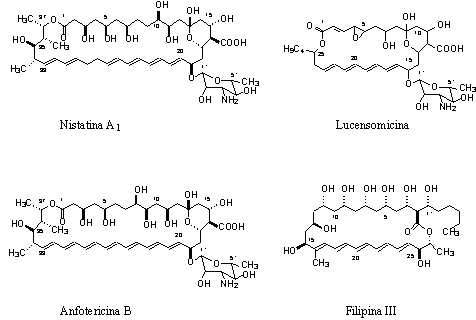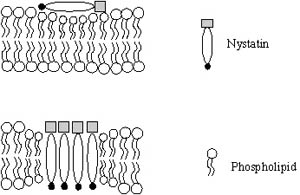 
Polyene Antibiotics
Polyene macrolide antibiotics isolated from
Streptomyces Gram-positive bacteria have been identified as antifungal
agents presenting a very low antibacterial activity. Amphotericin B
(AmB) and nystatin (Fig. 1), are two representative members of this
class of compounds that continue to play a major role in the treatment
of systemic and superficial fungal infections, respectively. However,
their utilization implies severe side effects that have restricted
their use as antifungal agents and promoted the development of various
liposomal formulations to minimize these problems.

|
|
Figure 1 - Structures of some polyene
antibiotics.
|
The polyene macrolide antibiotics are known
to exert their antibiotic activity via permeabilization of the target
plasma membrane of the antibiotic-sensitive organisms leading to a
leakage of ions and small molecules, ultimately causing cell
destruction. It has been shown that these molecules are able to
self-aggregate and form large conductance pores (Fig. 2) with
size-discriminating properties in model membrane systems, as well as
single ion channels in planar lipid bilayers (BLM). However, the
molecular details of the mechanism of antibiotic interaction with,
insertion into and final organization within the membranes are still
not clear. Particularly, one of the most intriguing questions related
to this class of compounds that still persists today is the elucidation
of the role of sterols - cholesterol and ergosterol - in their mode of
action.

|
|
Figure 2 - Schematic representation of
the main stages of nystatin interaction with a model system of
membranes. After adsorption to the membrane interface (top), the
antibiotics self-associate in a pore structure (bottom), when the
surface concentration is higher than a critical value. The structures
formed in the biological membranes are most probably mixed
antibiotic-sterol aggregates.
|
Our group has taken advantage of the
intrinsic fluorescence properties of some of these antibiotics to carry
out both steady-state and time-resolved fluorescence studies of their
interaction with phospholipid bilayer membranes. We are interested to
probe both the structure and activity of the antibiotic species formed
under different lipid compositions and sterol content. Insights
regarding the structure of the active species formed within the lipid
bilayer could significantly advance our understanding about the mode of
action of these antibiotics, eventually allowing for the design of more
selective and less toxic compounds.
go back to Research Interests
|